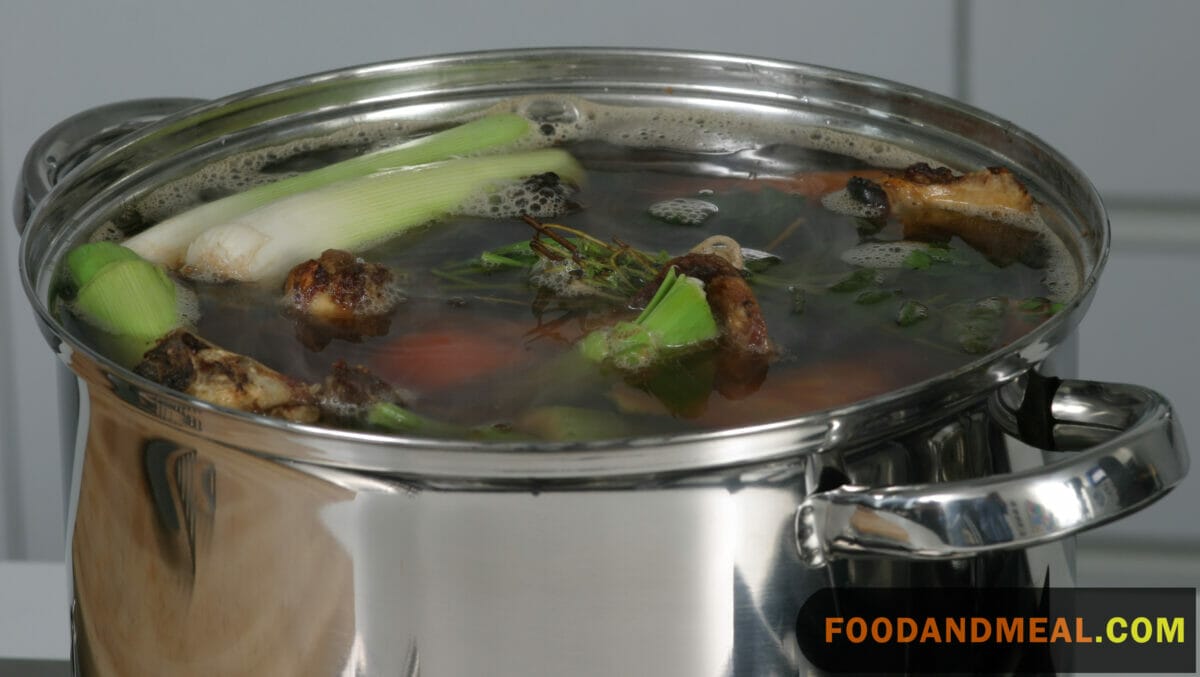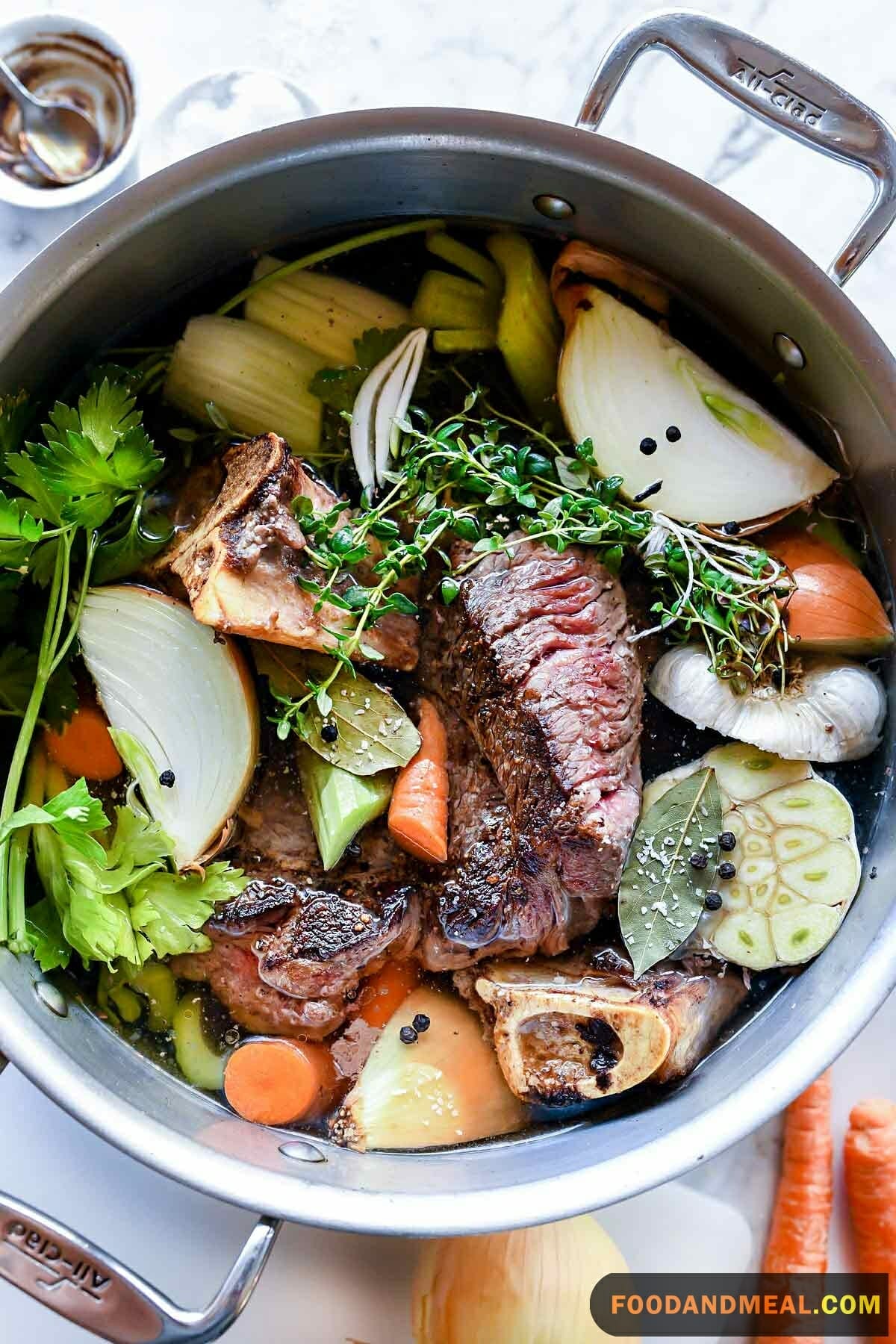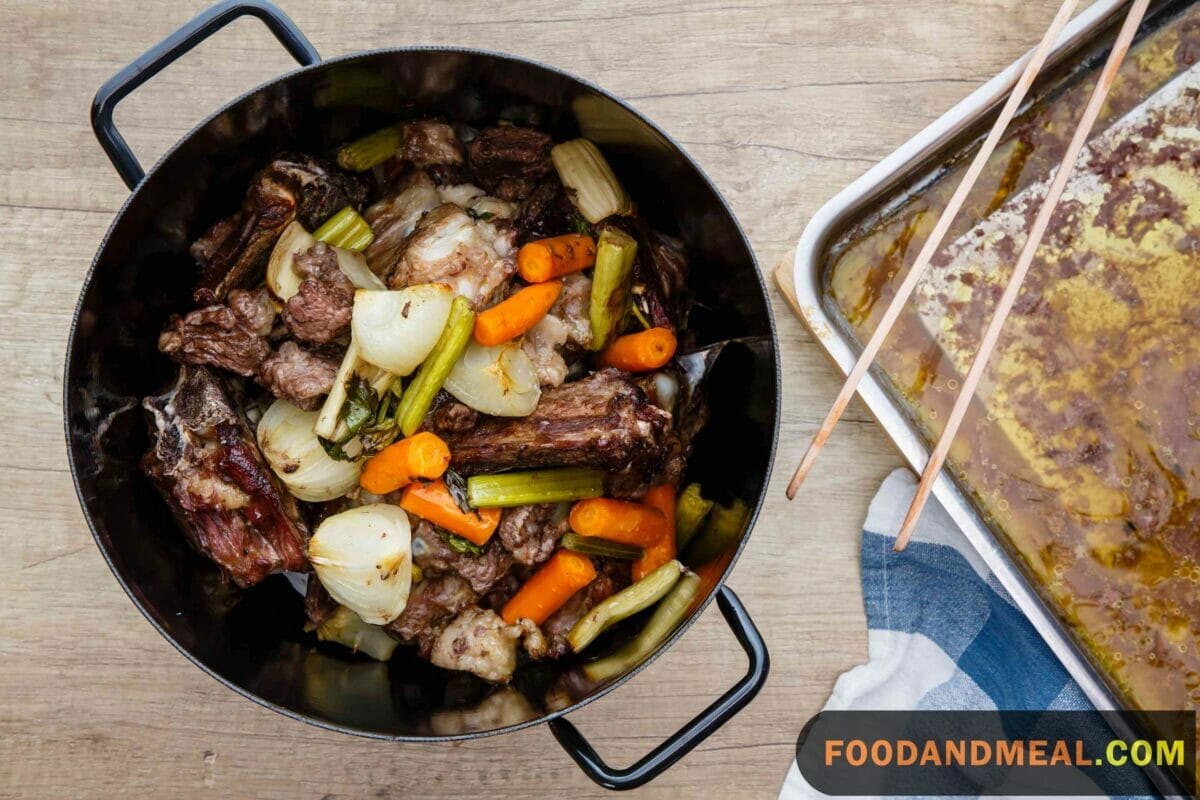As a passionate home cook and recipe developer at Food And Meal, I’m always on the lookout for ways to add more flavor to my dishes without much effort. That’s why rich, savory beef stock has become such an invaluable staple in my kitchen. Whenever I have beef bones leftover from a roast or steak night, I make sure to toss them in a pot to simmer into a potent, umami-packed broth.
Not only does homemade beef stock create an intensely beefy base for soups, stews and braises, but it also allows me to honor the whole animal and reduce food waste. I’ll admit, my first attempts at beef bone broth were pretty underwhelming. The flavor was dull and muted no matter how long I simmered those bones. After doing more research, I realized low and slow is key to extracting every ounce of goodness from beef marrow and connective tissue. Now I cook my beef stock gently for at least 12-24 hours until it turns luscious, dark brown and glossy with gelatin. That long extraction gives it an incredible meaty richness and mouth coating texture that lifts any dish. I like to freeze beef stock in batches so I always have this powerhouse ingredient on hand whenever the craving for a hearty beef soup or stew strikes!
With the chilly winter months approaching, I’m eager to share more of my favorite beef stock recipes with the Food And Meal community. From pho broth to pot roasts that fall apart with fork-tender perfection, let’s discover just how much added comfort and flavor beef bone broth can bring to all your cold weather dishes this season!

Beef Stock Recipe

BEEF STOCK
Equipment
Ingredients
- 2 pounds beef brisket, rinsed
- 8 quarts water, or enough to fill a large stockpot
Instructions
- In a large stockpot over high heat, bring the beef and water to a boil.
- Reduce the heat to low and simmer, uncovered, for at least 2 hours until fork-tender, skimming the top occasionally to remove the foam and fat.
- Transfer the brisket to a cutting board. You can slice it, shred it, and use it immediately or reserve it for later use.
- Use the broth immediately, or for later use, store it in the refrigerator for up to 1 week or in the freezer for up to 2 months.
Video
Notes
- Quality Ingredients, Rich Flavor: Start with high-quality beef bones and aromatic vegetables for a beef stock that's brimming with rich, hearty flavor. Ready to explore the essence of Korean cuisine? Let's dive into the recipe and create a base that elevates your dishes!
- Gentle Simmering for Elegance: Simmer the ingredients gently to draw out their essence and depth of flavor. Avoid boiling vigorously to ensure a clear and flavorful stock. Eager to infuse your dishes with umami goodness? Let's gather our ingredients and embark on a culinary journey.
- Skimming for Clarity: Skim the impurities that rise to the surface during simmering for a clean and clear stock that's perfect for enhancing various recipes.
Nutrition
© Food And Meal
This website provides approximate nutrition information for convenience and as a courtesy only. Nutrition data is gathered primarily from the Spoonacular Database, whenever available, or otherwise other online calculators.
Beef stock and beef broth the same?
Beef Stock
When it comes to beef stock, there’s something deeply comforting about its rich and hearty essence. The slow simmering of bones, meat, and aromatic vegetables creates a liquid gold that’s brimming with flavor. The roasted bones add a robust depth, making it the perfect foundation for heartwarming soups and stews. The velvety texture and intense aroma make beef stock a culinary marvel, bringing a sense of warmth and nostalgia to the kitchen.
Beef Broth
On the other hand, there’s a simplicity and purity to beef broth that I find quite delightful. The gentle simmering of meat, vegetables, and seasonings results in a liquid that is clear, light, and versatile. It’s like a blank canvas waiting to be painted with various culinary creations. Beef broth, with its straightforward flavor profile, is a go-to for me when I want to infuse dishes with a subtle, savory essence. It’s not as intense as stock, but it possesses a charm of its own.
Cooking Tips

Patience is key. Letting the bones bubble gently for a minimum of 12 hours, and up to 24, allows more gelatin and minerals to be released for better body and taste. Skim the film and impurities that rise to keep things clear.
Add some acidity upfront with a splash of apple cider or red wine vinegar. This helps leach more nutrients from the bones.
Roast the bones before simmering for deeper color and caramelized savoriness.
Mirepoix aromatics like onion, carrot and celery balance the flavor. For extra depth, I also like to add a bay leaf, peppercorns and parsley.
Letting the strained stock cool in the fridge overnight helps the fat separate and solidify for easier removal. This also allows the collagen to fully set into an indulgent, gravy-like texture when reheated.
Serving Suggestions

Picture indulging in the timeless elegance of Veal Gremolata, elevated to new heights with a reduction crafted from the rich and savory essence of beef stock. The resulting symphony of tastes transforms a classic dish into a culinary masterpiece that speaks to the soul. Similarly, Steak Teriyaki takes on a velvety allure with a glaze made from beef stock, adding a layer of sophistication that resonates with every savory bite. For those seeking comfort, envision the heartwarming embrace of Sui-Gyoza Soup, where beef stock forms the backdrop, allowing the delicate dumplings to shine in a bowl of sheer coziness. The infusion of beef stock into Tonkotsu Ramen unveils a culinary adventure, creating a unique and satisfying experience that is both comforting and indulgent. These serving suggestions aim to not just satiate the appetite but also to elevate the dining experience, blending the richness of beef stock with emotions and a touch of personal opinion.
Frequently Asked Questions of Beef Stock

- What is a beef stock? Beef stock is a flavorful liquid obtained by simmering beef bones, meat, vegetables, and herbs in water. This slow-cooking process extracts rich flavors, resulting in a versatile base for soups, stews, sauces, and various other culinary applications.
- What stock is best for beef? The best stock for beef-based dishes is homemade Beef Stock. Crafting it from scratch allows you to control the ingredients, ensuring a depth of flavor that complements and enhances beef-centric recipes.
- What’s the difference between beef stock and bone broth? While similar, beef stock typically involves simmering bones, meat, and vegetables, focusing on extracting flavors. Bone broth, on the other hand, involves longer simmering times, aiming to extract collagen and gelatin from bones. Both have rich flavors but may serve different culinary purposes.
- What is the difference between broth and stock? Broth and stock share a base of water, meat, vegetables, and aromatics, but they differ in preparation and intensity. Stock is simmered for a longer time, extracting flavors from bones, resulting in a richer, more concentrated liquid. Broth, however, is a lighter, quicker-cooked liquid, showcasing a simpler flavor profile
- Can I use pre-packaged beef broth instead of homemade Beef Stock? While pre-packaged broth can be a convenient option, homemade Beef Stock offers a depth of flavor that’s unparalleled. It’s worth the effort!
- Can I freeze leftover Beef Stock? Absolutely! Allow the stock to cool, then transfer it to airtight containers or freezer bags. It can be stored in the freezer for up to 3 months.
- Is Beef Stock suitable for vegetarians or vegans? Unfortunately, Beef Stock is not suitable for vegetarians or vegans as it is made from beef bones. Consider vegetable stock as an alternative.
- Can I adjust the intensity of the stock’s flavor? Certainly! Adjust the simmering time and the quantity of bones and vegetables to achieve your desired flavor intensity.
- How do I reheat Beef Stock for use in recipes? Gently warm the frozen or refrigerated Beef Stock over low to medium heat. Avoid boiling to preserve the stock’s quality.
Conclusion
In conclusion, homemade beef stock is a simple yet powerful way to add rich, meaty flavor to all kinds of dishes. After learning the keys to extracting the most gelatin, collagen and minerals from beef bones through long, gentle simmering, I now have a hearty broth that enhances everything from Asian noodle soups to hearty American stews. Beef stock has become my not-so-secret weapon for making comforting, soul-satisfying meals quickly.
I hope the tips and serving suggestions I’ve shared here on the Food And Meal blog have inspired you to start simmering your own beef bones into lip-smacking liquid gold. As the weather gets cooler, a batch of beef stock is like a warm, flavorful hug in a bowl. Let’s carry on the traditions of using the whole animal and reducing waste through homemade bone broths. Please share your own beloved beef stock recipes in the comments, I can’t wait to discover more ways to elevate my home cooking with this versatile ingredient.
Hi! I'm Nazia of ‘Nazia Cooks’, a self-taught baker and cook residing in Chennai. Rooted in the rich South Indian culinary landscape, my palate has expanded to embrace global flavors. I revel in crafting fusion dishes, melding traditions to birth unique tastes.


